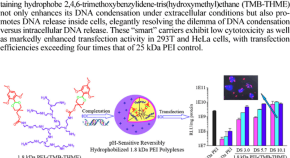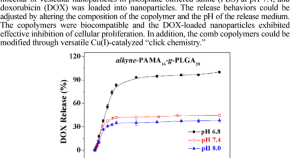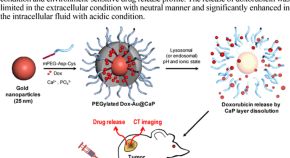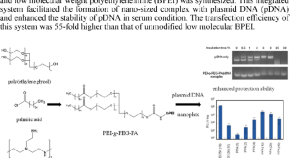Collection
Special Issue for Theranostic Macromolecules
- Submission status
- Closed
Macromolecular Research has been launched in 1993 under the name of “Korea Polymer Journal” by the Polymer Society of Korea (PSK). The name of journal was changed to “Macromolecular Research” from 2002 after growing up to be included in Science Citation Index (SCI). Recently, the number of submitted papers and the impact factor of Macromolecular Research have been continuously raising up.
As a new activity to attract broad interests of the readers and to boost up the quality of the journal, the Editor-in-Chief Prof. Chulhee Kim decided to introduce the special issues in which some different research fields are introduced once in a while. The Editorial Board chose me as the first guest editor, since I started the Engineering Research Center in 2010 supported by National Research Foundation of Korea.
During the first decade of the 21st century, a new research trend was born for developing of innovative diagnostic and therapeutic systems based on nanobiotechnology. The new terminology “theranostics” has been created a couple of year ago, which means “the combined delivery of therapeutic and diagnostic agents”. This “theranostics” can be achieved effectively by using functional biomedical polymers, so that the title of this special issue is “Theranostic Macromolecules”.
The biomedical polymer division of PSK has been founded in 1993. The first International Symposium on Biomaterials and Drug Delivery (ISBD) was organized by Dr. Hae Bang Lee in Daejeon in 1993, and was held three times in consecutive year. And the biomedical polymer division meeting was held two times every year together with the annual meeting of PSK, where young scientists get together for interdisciplinary discussions. Successful achievements have been made since then and the importance of biomaterials and drug delivery system (DDS) is now widely recognized in Korea. The total presentation of the biomaterials division was 144 papers in the annual fall meeting of PSK in 2011.
With this special issue, I invited leading scientists from Korea, Japan, China and USA who have contributed significantly to the DDS field from the polymer sciences as well as the pharmaceutical sciences. This issue includes a feature article for stimuli sensitive polymers, and the articles on nanoparticles for drug delivery and molecular imaging, hydrogels for sustained delivery, new biomaterials for drug delivery, biomaterials for gene delivery.
I anticipate that this cutting edge science will be extended to translational research and contribute to the discovery of biomaterials for new drugs and related development in the near future. I express my deepest gratitude to the Editors of Macromolecular Research for their editorial help and this opportunity.
Editors
-
Doo Sung LEE
SungKyunKwan University, Korea
Articles (16 in this collection)
-
-
Polysuccinimide graft copolymer nano aggregates encapsulating magnetites for imaging probe
Authors
- Hyunjung Kim
- Dukjoon Kim
- Content type: Articles
- Published: 29 March 2012
- Pages: 259 - 265

-
Gold half-shell coated hyaluronic acid-doxorubicin conjugate micelles for theranostic applications
Authors (first, second and last of 5)
- Ki Su Kim
- Sang-Jun Park
- Sei Kwang Hahn
- Content type: Articles
- Published: 29 March 2012
- Pages: 277 - 282

-
Multi-core vesicle nanoparticles for controlled delivery of protein drug
Authors (first, second and last of 8)
- Soon Hong Yuk
- Keun Sang Oh
- Ick Chan Kwon
- Content type: Articles
- Published: 29 March 2012
- Pages: 309 - 312

-
Thermosensitive block copolymers PEG-b-PBEMAGG containing functional pendant amino groups
Authors
- Zhenke Wei
- Qingsong Yu
- Zhihua Gan
- Content type: Articles
- Published: 29 March 2012
- Pages: 313 - 318

-
α-amino acid pendant polymers as endosomal pH-responsive gene carriers
Authors (first, second and last of 4)
- Takuya Wada
- Arihiro Kano
- Atsushi Maruyama
- Content type: Articles
- Published: 29 March 2012
- Pages: 302 - 308

-
Biodegradable nanogel-integrated hydrogels for sustained protein delivery
Authors (first, second and last of 4)
- Asako Shimoda
- Yuka Yamamoto
- Kazunari Akiyoshi
- Content type: Articles
- Published: 29 March 2012
- Pages: 266 - 270

-
Modulation of cell adhesion of heparin-based hydrogel by efficient physisorption of adhesive proteins
Authors (first, second and last of 4)
- Mihye Kim
- Yang-Jung Kim
- Giyoong Tae
- Content type: Articles
- Published: 29 March 2012
- Pages: 271 - 276

-
Polycaprolactone scaffold modified with galactosylated chitosan for hepatocyte culture
Authors (first, second and last of 7)
- Yuan Qiu
- Zhengwei Mao
- Changyou Gao
- Content type: Articles
- Published: 29 March 2012
- Pages: 283 - 291

-
pH-sensitive degradable hydrophobe modified 1.8 kDa branched polyethylenimine as “artificial viruses” for safe and efficient intracellular gene transfection
Authors (first, second and last of 5)
- Meng Zheng
- Chunmei Yang
- Zhiyuan Zhong
- Content type: Articles
- Published: 29 March 2012
- Pages: 327 - 334

-
pH-sensitive polymers for drug delivery
Authors (first, second and last of 4)
- Kang Moo Huh
- Han Chang Kang
- You Han Bae
- Content type: Feature Article
- Published: 29 March 2012
- Pages: 224 - 233

-
pH-responsive drug delivery systems based on clickable poly(L-glutamic acid)-grafted comb copolymers
Authors (first, second and last of 6)
- Jianxun Ding
- Chaoliang He
- Xuesi Chen
- Content type: Articles
- Published: 29 March 2012
- Pages: 292 - 301

-
Synthesis, characterization, and drug delivery of amphiphilic poly{(lactic acid)-co-[(glycolic acid)-alt-(L-glutamic acid)]}-g-poly(ethylene glycol)
Authors (first, second and last of 8)
- Zuxiao Yu
- Bin He
- Zhongwei Gu
- Content type: Articles
- Published: 29 March 2012
- Pages: 250 - 258

-
Development of a pH sensitive nanocarrier using calcium phosphate coated gold nanoparticles as a platform for a potential theranostic material
Authors (first, second and last of 6)
- Eui-Joon Cha
- In-Cheol Sun
- Cheol-Hee Ahn
- Content type: Articles
- Published: 29 March 2012
- Pages: 319 - 326

-
Enhanced gene delivery by palmitic acid-conjugated low molecular weight polyethylenimine
Authors (first, second and last of 5)
- Duhwan Lee
- Kaushik Singha
- Won Jong Kim
- Content type: Articles
- Published: 09 January 2012
- Pages: 244 - 249

-
In vitro degradation and protein release of transparent and opaque physical hydrogels of block copolymers at body temperature
Authors
- Lin Yu
- Zheng Zhang
- Jiandong Ding
- Content type: Articles
- Published: 09 January 2012
- Pages: 234 - 243



